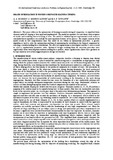JavaScript is disabled for your browser. Some features of this site may not work without it.
| dc.contributor.author | Skordos, Alexandros A. | - |
| dc.contributor.author | Monroy, Aceves C. | - |
| dc.contributor.author | Sutcliffe, Michael P. F. | - |
| dc.date.accessioned | 2011-04-14T23:19:12Z | |
| dc.date.available | 2011-04-14T23:19:12Z | |
| dc.date.issued | 2005-07-01T00:00:00Z | - |
| dc.identifier.citation | A. A. Skordos, C. Monroy Aceves and M. P. F. Sutcliffe Drape optimization in woven composites manufacture 5th International Conference on Inverse Problems in Engineering, July 11-15, 2005, Cambridge,UK | en_UK |
| dc.identifier.uri | http://dspace.lib.cranfield.ac.uk/handle/1826/2386 | |
| dc.description.abstract | This paper addresses the optimisation of forming in manufacturing of composites. A simplified finite element model of draping is developed and implemented. The model incorporates the non-linear shear response of textiles and wrinkling due to buckling of tows. The model is validated against experimental results and it is concluded that it reproduces successfully the most important features of the process. The simple character of the model results in low computational times that allow its use within an optimisation procedure. A genetic algorithm is used to solve the optimisation problem of minimising the wrinkling in the formed component by selecting a suitable holding force distribution. The effect of regularisation is investigated and the L-curve is used to select a regularisation parameter value. Optimised designs resulting from the inversion procedure have significantly lower wrinkling than uniform holding force profiles, while regularisation allows force gradients to be kept relatively low so that suggested process designs are feasible. | en_UK |
| dc.language.iso | en_UK | en_UK |
| dc.title | Drape optimization in woven composites manufacture. | en_UK |
| dc.type | Article | en_UK |
Files in this item
This item appears in the following Collection(s)
-
Staff publications (SAS) [907]
